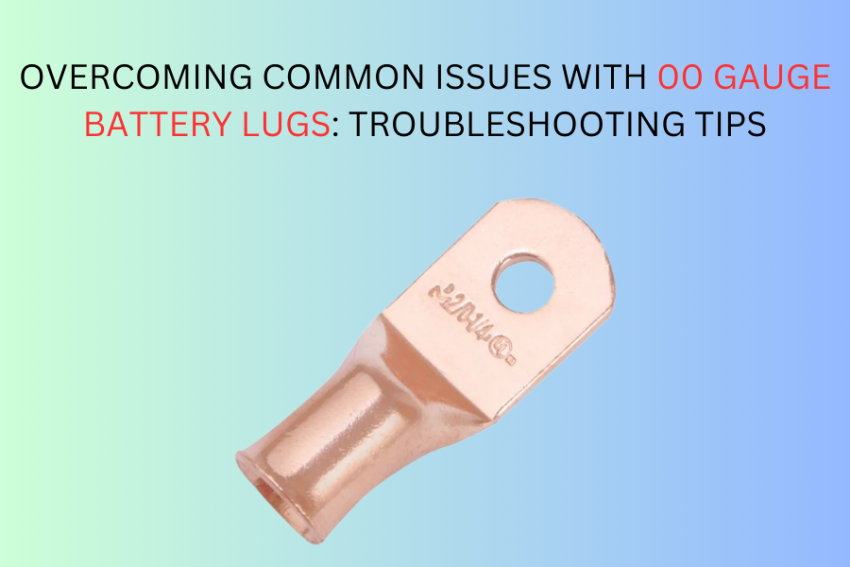00 Gauge Battery Lugs are essential components in heavy-duty electrical systems, ensuring reliable power transmission in vehicles, marine applications, and renewable energy systems. Despite their robust design, users often encounter several common issues that can compromise the performance and safety of their electrical setups. This article explores these issues and provides troubleshooting tips to help you overcome them.
Issue 1: Poor Connection and Corrosion
One of the most prevalent problems with 00 gauge battery lugs is poor electrical connection, often caused by corrosion. Corrosion occurs when the lugs are exposed to moisture and air, leading to oxidation of the metal. This can result in increased electrical resistance, reduced conductivity, and potential failure of the electrical system.
Troubleshooting Tips:
1. Clean Regularly: Inspect battery lugs regularly for signs of corrosion. Clean them using a wire brush or sandpaper to remove oxidation. For stubborn corrosion, a mixture of baking soda and water can be applied to neutralize the acid.
2. Apply Protective Coatings: After cleaning, apply a thin layer of dielectric grease or a corrosion inhibitor to the lugs. This creates a barrier against moisture and air, reducing the risk of future corrosion.
3. Seal Connections: Use heat shrink tubing or electrical tape to seal the connections, especially in environments prone to moisture. This helps to keep the lugs dry and prevents corrosion.
Issue 2: Loose Connections
Loose connections can lead to intermittent power delivery, overheating, and even electrical fires. This issue often arises due to improper installation or the natural loosening of connections over time due to vibrations.
Troubleshooting Tips:
1. Tighten Regularly: Check the tightness of the connections regularly, particularly in high-vibration environments like vehicles. Use a torque wrench to ensure that the lugs are tightened to the manufacturer’s specifications.
2. Use Lock Washers: Install lock washers or lock nuts to prevent the connections from loosening over time. These components add extra resistance against vibrations and thermal expansion.
3. Inspect for Wear: Regularly inspect the lugs and cables for signs of wear, such as frayed wires or deformed lugs. Replace any damaged components immediately to maintain a secure connection.
Issue 3: Overheating
Overheating of 00 gauge battery cable lugs can occur due to high current loads, poor connections, or inadequate ventilation. Overheated lugs can lead to melting insulation, damage to surrounding components, and potential electrical fires.
Troubleshooting Tips:
1. Ensure Proper Sizing: Verify that the lugs and cables are appropriately sized for the electrical load. Using undersized lugs or cables can result in excessive heat buildup.
2. Improve Ventilation: Ensure that the electrical system has adequate ventilation to dissipate heat. In enclosed spaces, consider installing fans or vents to improve airflow.
3. Monitor Temperature: Use an infrared thermometer to monitor the temperature of the lugs during operation. If they are consistently running hot, investigate and address the underlying cause.
Issue 4: Inadequate Crimping
Proper crimping of 2/0 Gauge Lugs is crucial for ensuring a reliable connection. Inadequate crimping can lead to poor conductivity, increased resistance, and eventual failure of the connection.
Troubleshooting Tips:
1. Use Quality Crimping Tools: Invest in high-quality crimping tools designed for 00 gauge lugs. These tools provide the necessary force and precision to create a secure crimp.
2. Follow Manufacturer Guidelines: Adhere to the crimping guidelines provided by the lug and tool manufacturers. This includes using the correct die size and applying the recommended crimping force.
3. Inspect Crimps: After crimping, inspect the lugs for signs of a good crimp, such as a solid connection and no visible gaps. Perform a pull test to ensure the wire is securely attached to the lug.
Issue 5: Incorrect Lug Selection
Using the wrong type or size of battery lug for your application can lead to a range of issues, including poor conductivity, overheating, and mechanical failure.
Troubleshooting Tips:
1. Match Lugs to Cables: Ensure that the lugs are correctly matched to the cable size and type. 00 gauge lugs should be used with 00 gauge cables, and the lug material should be compatible with the cable material.
2. Consider Environmental Factors: Choose lugs that are suited for the environmental conditions of your application. For example, in marine environments, use marine-grade lugs that resist corrosion from saltwater.
3. Consult Specifications: Refer to the manufacturer’s specifications and guidelines to select the appropriate lugs for your electrical system. This includes considering factors such as current capacity, temperature ratings, and mechanical strength.
Conclusion
2/0 Gauge Lugs are vital components in heavy-duty electrical systems, but they are not immune to issues such as poor connections, corrosion, loose connections, overheating, inadequate crimping, and incorrect lug selection. By following the troubleshooting tips outlined in this article, you can ensure that your battery lugs provide reliable and safe performance. Regular maintenance, proper installation, and vigilant monitoring are key to overcoming these common issues and maintaining the integrity of your electrical system.

